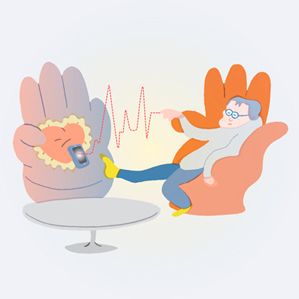Track Your Heart with Your Phone, Even If Your Phone’s in Your Bag
If you’re tired of wearable fitness trackers fighting for space on your wrist, it might not be a problem in the near future: researchers say they can reliably measure your heart and breathing rates just by looking at data from a smartphone sitting in your pocket or bag.

Researchers at MIT are working on a project called BioPhone that derives these biological signals from your smartphone’s accelerometer, which they say can capture the small movements of your body that result from the beating of your heart and rising and falling of your chest. A paper on the work was presented at a conference in August.
Javier Hernandez, a research scientist at MIT’s Media Lab and lead author of the paper, says it’s meant to capture this data during moments when you’re not moving much—this makes it easier to pick up such small vibrations without having to account for lots of other bodily movements—and, ideally, the data could be used to help figure out when you’re stressed out, and then help you cope with it. For example, your smartphone might suggest you try some breathing exercises or ask a loved one to give you a call.
The work builds on ongoing efforts by Hernandez and his colleagues to use mobile devices—and wearables, in particular—for measuring heart and breathing rates in less obtrusive ways in hopes of tracking your stress level. A previous project called BioGlass, for instance, used Google Glass to keep tabs on these biological signals by looking at data from the gyroscope, accelerometer, and camera built into the head-worn device (see “Google Glass Can Now Track Your Stress Level”).
To get a sense of the potential utility of BioPhone, researchers had a dozen study participants sit, stand, and lie down before and after pedaling on an exercise bike with an Android smartphone in their pocket (to capture data from the phone’s accelerometer). When they were standing up, participants also held a bag in the left hand and carried one over the right shoulder, each of which had a data-gathering smartphone tucked inside.
For all the different activities, they wore FDA-approved sensors for capturing heart and breathing rates, so the data gathered from the smartphones could be compared with measurements already known to be reliable.
On average, the heart rates estimated by analyzing the smartphone data were off by slightly more than one beat per minute, and breathing rate estimations were off by about a quarter of a breath per minute.
However, Emil Jovanov, an associate professor at the University of Alabama in Huntsville who co-directs a lab focused on tracking mobile health and wellness and directs a lab for real-time physiological monitoring, says it’s “probably a stretch” to say that the researchers can accurately detect a person’s heartbeat from a phone in a bag or a pocket, due to factors like extra signal noise resulting from things such as inadvertent hand motions.
“Sensors are definitely much better quality than they used to be in the early days of smartphones,” he says. “However, their quality is still not sufficient for sophisticated applications.”
Hernandez says there are still challenges to overcome. He points out that researchers still have to figure out how to measure heart and breathing rates reliably when the smartphone is in different spots, like your back pants pocket versus your t-shirt pocket or a purse, which can change how the biological signals are picked up—in general, the farther you get from the heart, the harder it is to get a good reading.
Keep Reading
Most Popular
Large language models can do jaw-dropping things. But nobody knows exactly why.
And that's a problem. Figuring it out is one of the biggest scientific puzzles of our time and a crucial step towards controlling more powerful future models.
The problem with plug-in hybrids? Their drivers.
Plug-in hybrids are often sold as a transition to EVs, but new data from Europe shows we’re still underestimating the emissions they produce.
Google DeepMind’s new generative model makes Super Mario–like games from scratch
Genie learns how to control games by watching hours and hours of video. It could help train next-gen robots too.
How scientists traced a mysterious covid case back to six toilets
When wastewater surveillance turns into a hunt for a single infected individual, the ethics get tricky.
Stay connected
Get the latest updates from
MIT Technology Review
Discover special offers, top stories, upcoming events, and more.